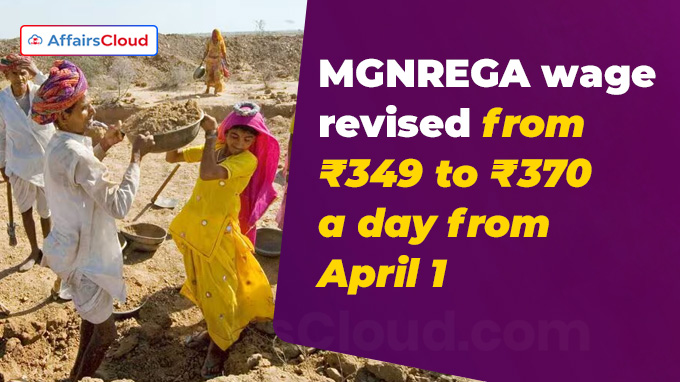 In March 2025, the Ministry of Rural Development (MoRD) issued a notification regarding the revised wages under Mahatma Gandhi National Rural Employment Guarantee Act (MGNREGA) for Financial Year 2025-26 (FY26). This notification was issued under sub-section (1) of Section 6 of MNREGA, 2005.
In March 2025, the Ministry of Rural Development (MoRD) issued a notification regarding the revised wages under Mahatma Gandhi National Rural Employment Guarantee Act (MGNREGA) for Financial Year 2025-26 (FY26). This notification was issued under sub-section (1) of Section 6 of MNREGA, 2005.
- As per notification, the daily wage for workers under MGNREGA has been raised from existing Rs 349 to Rs 370 a person.
- The revised rates came into effect from the 1st day of FY26 i.e. from April 1, 2025.
Key Changes in Wages:
i.The wages under MGNREGA has been hiked in the range of 2.33%-7.48% i.e. wages has witnessed an increase in the range of Rs 7 to Rs 26.
ii.As per MoRD, the National Rural Employment Guarantee Scheme (NREGS) wages have been raised by Rs 7 in 5 states: Andhra Pradesh (AP), Arunachal Pradesh (AR), Assam, Nagaland, and Telangana.
iii.Among all the Indian states, Haryana recorded the highest increase of Rs 26 in NREGS wages i.e. from existing rate of Rs 374 per day to Rs 400 per day for FY26.
- This will be the time ever the NREGS wages will reach daily wage of Rs 400 in any state.
Key Points:
i.The wages under MGNREGA are fixed as per the changes in the Consumer Price Index for Agricultural Labourers (CPI-AL), which shows the increase in inflation in rural areas.
ii.Goa had witnessed the highest hike of 10.56% in FY25 compared to FY23 wage rate; While, Uttar Pradesh (UP), and Uttarakhand registered the lowest wage rate of 3.04%.
iii.During FY25, 5.66 crore households have availed the benefits of MGNREGA scheme till March 19, 2025.
About Mahatma Gandhi National Rural Employment Guarantee Act (MGNREGA):
i.In September 2005, the Government of India (GoI) introduced MGNREGA, 2005. The Act provides a legal guarantee of providing minimum 100 days of wage employment in a financial year to every rural household, whose adult members are interested to do unskilled manual work.
ii.It is a Centrally Sponsored Scheme (CSS) under which GoI and state governments provide financial assistance in the ratio of 90:10, respectively.
iii.As per the scheme, at least 1/3rd (33%) of wage seekers should be women.
iv.The scheme is being implemented through Panchayati Raj Institutions (PRIs). The Block Programme Officer (BPO) is required to allot 50% of work in terms of cost to the Gram Panchayat (GP).
v.Under the scheme, Gram Sabha (GS) recommends work and the GP identifies or approves the works for implementation.
About Ministry of Rural Development (MoRD):
Union Minister– Shivraj Singh Chauhan (Constituency- Vidisha, Madhya Pradesh, MP)
Union Minister of State (MoS)- Chandra Shekhar Pemmasani (Constituency- Guntur, Andhra Pradesh, AP); and Kamlesh Paswan (Constituency- Bansgaon, Uttar Pradesh, UP)




